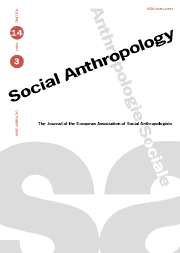No CrossRef data available.
Article contents
Inner iconoclasm. Forms of reflexivity in Loma rituals of sacrifice
Published online by Cambridge University Press: 06 March 2002
Abstract
Loma religion, involving masquerade and secret cult activities, has remained largely intact in spite of continuous suppression of local religious practices in the Republic of Guinea during the decades following independence. The article aims at explaining the apparent immunity to iconoclastic practices through the analysis of a ritual of sacrifice which illustrates how the Loma conceive of religious objects as artefacts and living kinds. The study elucidates a mode of reflexivity, labelled inner iconoclasm, which refers to people's ability to reflect upon their own religious beliefs as these are generated and unfold in the course of ritual action. It is argued that various aspects of reflexivity intrinsic to ritual action are main factors explaining the apparent immunity of Loma religion to iconoclastic practices. A second belief-generating mode of reflexivity is the objectification of religion resulting from the exposure of ritual secrets and the current politicisation of ritual practice and cult organisations.
- Type
- Research Article
- Information
- Copyright
- © 2002 European Association of Social Anthropologists




